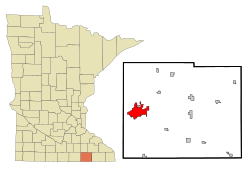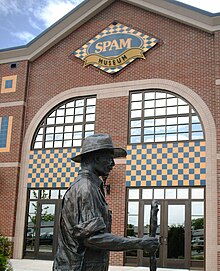Austin, Minnesota
City of Austin | |
|---|---|
| Nickname(s): Spamtown, USA | |
 Location of Austin within Mower County, Minnesota | |
| Country | United States |
| State | Minnesota |
| County | Mower |
| Established | 1853 |
| Incorporated | 1856 |
| Government | |
| • Mayor | Tom Stiehm |
| Area | |
| • Total | 10.84 sq mi (28.08 km2) |
| • Land | 10.75 sq mi (27.84 km2) |
| • Water | 0.09 sq mi (0.23 km2) |
| Elevation | 1,184 ft (360 m) |
| Population (2000)[1] | |
| • Total | 23,314 |
| • Density | 2,168.2/sq mi (837.2/km2) |
| Time zone | UTC-6 (CST) |
| • Summer (DST) | UTC-5 (CDT) |
| ZIP code | 55912 |
| Area code | 507 |
| FIPS code | 27-02908Template:GR |
| GNIS feature ID | 0639531Template:GR |
| Website | www.ci.austin.mn.us |


Austin is a city in Mower County, Minnesota, United States. The population was 23,314 at the 2000 census. It is the county seat of Mower County6. The southern part of the city is in Austin Township while the northern part is in Lansing Township; the city is politically independent of both. It is located at the intersection of Interstate 90 and U.S. 218 in the southeastern part of the state. The town was originally settled along the Cedar River and it has two man-made lakes called East Side Lake and Mill pond.
The meat packer Hormel Foods Corporation is the largest employer in Austin, where its factory makes most of North America's Spam tinned meat. The Austin Area Chamber of Commerce sponsors an annual Independence Day Freedom Fest. "Spam Town USA," as Austin is sometimes called, is also home to the Spam Museum. American Football Coach John Madden was born in Austin.
History
19th century
In 1853 Austin Nichols (namesake of the city, named in 1856) built the first log cabin on the Cedar River (also called the Red Cedar River), which he sold to Chauncey Leverich in 1854. Leverich built the first sawmill here in 1854-55 and supplied the earlier settlers with lumber. A Methodist preacher first held services in 1855. Settlers in covered wagons full of belongings and followed by livestock came into the area, and on March 1, 1856, Governor Willis A. Gorman signed the act that organized Mower County. It was named after John Edward Mower, a member of the territorial legislature. The first hotel was started in 1856 by J.H. McKinley, and that year Dr. Ormanzo Allen became the small town's first doctor.
School had been held in a small cabin near Leverich's mill as early as 1854, but by 1857 school was being taught by Maria Vaughn in the Robert Audis building. That year W.A. Woodson started to butcher and dress pork for sale and the first Congregational Church services were held in the Old Headquarters Building. The Truesdell brothers built the first grist mill in 1858, thereby reducing the need for oxen-freight flour from Decorah and Chatfield. 1858 also saw the city's first newspaper, the Mower County Mirror, and the beginning of public utilities and street lamps. The Oakwood Cemetery and the first library (started by the Floral Club) were also started in 1858.
The first permanent school building was built in 1865, and Harlan Page opened the first bank the following year. The Chicago, Milwaukee, St. Paul, and other smaller rail lines were established in 1867-69, thus turning the growing town into a small rail hub. First National was granted a U.S. Government bank charter in 1868. In 1885, service on the Chicago Great Western Railway first started in Austin. George A. Hormel started George A. Hormel & Co. in 1892. Dr. O.H. Hegge and area Lutherans organized the Austin Hospital Association, and thus St. Olaf Hospital was established as a non-profit organization. Charles Boostrom opened the Southern Minnesota Normal College and Austin College of Commerce in 1897; both remained open until 1925.
20th century
The Austin Park Board was created in 1902 to build and maintain the city's parks. On March 10, 1903, the city adopted a Home Rule Charter that still forms the basis of city government to this day. The original Austin Public Library, one of the nation's many Carnegie libraries, was completed in 1904. The Recreation Board was created in 1939. In April 1949 the Park Board and the recreation Board were merged to become the Austin Park and Recreation Board. The last passenger train (the Chicago Great Western Railway) left Austin on September 30, 1965, and Austin has not had passenger service since. Ground was broken for the Salvation Army building on October 16, 1967. The Jay C. Hormel Nature Center was created in 1971 when the land was purchased from Geordie Hormel with a state grant. Riverside Arena opened in 1973. Victor Borge performed with the Austin Symphony Orchestra on April 28, 1977. Austin had a bad flood on July 6-7, 1978, when the waters reached 19.5 inches. Over 1,000 homes and businesses were damaged. Ten days later, 16 inches of rain fell at Waltham and the Cedar River crested in Austin at 21 feet, 9 inches.
From August 1984 until June 1985, there was a major strike at Hormel that resulted in then-Governor Rudy Perpich requesting National Guard intervention allowing replacement workers to enter the plant. This strike was documented in the Academy Award-winning Barbara Koppel film, "American Dream." The town still remains divided over the issue of labor unions at the plant.
21st century
Packer Arena opened in 2004.
Geography and Climate
According to the United States Census Bureau, the city has a total area of 28.1 km² (10.8 mi²). 27.8 km² (10.8 mi²) of it is land; 0.2 km² (0.1 mi²) (0.83%) is water. Its elevation is approximately 1,200 ft.
Major Tornadoes
August 20, 1928
F-2 size. Touchdown on Winona Street (1st Ave.) damage path ran from the southern edge of Austin High School to the Milwaukee Road railyards on the city's east side. Buildings ruined or damaged: St. Olaf Lutheran church, Carnegie Library, main street, spire on the old courthouse, Paramount Theatre, Austin Utilities, Lincoln school, damage to boxcars at Milwaukee yards before it dissipated. Austin residents noticed debris raining out of the sky, such as straw and laundry.
August 1961
F-0 Touchdown in backyard at 818 18th St. S.W. (Sucha residence) Gained strength as F-1, when it hit block at 17th St. S.W. and blew up a garage. Lifted and touched down in fairgrounds and hit the grandstand roof, tearing off parts and damaging beams.
June 30, 1998
Disputed tornado or straight line winds took down massive amounts of branches and trees, uprooting smaller trees and knocking large branches across streets. In the northwest quarter of the city, the storm had the effect of blocking several side streets, 8th Ave Northwest near Sumner School, and 14th St. Northwest between I-90 and 8th Ave. The event caused disruption in Sunday church services the next morning as many congregations organized clean up activities instead of regularly scheduled events.
May 1, 2001
Touchdown in Glenville, with twister gaining strength before it turned into a F-3 headed for Austin. Dissipated before hitting town. Notable damage path in Glenville, and damage in Austin.
Major Floods
September 2004
A huge rainstorm caused a major flood throughout Austin and surrounding areas. Two people died. Many businesses were flooded. Everyone in Austin worked together to fix up the city.
Demographics
As of the census² of 2000, there were 23,314 people, 9,897 households, and 6,076 families residing in the city. The population density was 837.4/km² (2,168.2/mi²). There were 10,261 housing units at an average density of 368.5/km² (954.3/mi²). The racial makeup of the city was 92.6% White, 0.81% African American, 0.18% Native American, 2.22% Asian, 0.02% Pacific Islander, 3.09% from other races, and 1.09% from two or more races. Hispanic or Latino of any race was 6.12% of the population.
There were 9,897 households, out of which 27.2% had children under the age of 18, 48.6% were married couples living together, 9.5% had a female householder with no husband present, and 38.6% were non-families. 33.4% of all households were made up of individuals and 17.2% had someone living alone who was 65 years of age or older. The average household size was 2.29; the average family size was 2.90.
In the city the population was spread out, with 23.3% under the age of 18, 8.7% from 18 to 24, 25.1% from 25 to 44, 20.9% from 45 to 64, and 22.0% who were 65 years of age or older. The median age was 40 years. For every 100 females there were 92.9 males. For every 100 females age 18 and over, there were 89.2 males.
The median income for a household in the city was $33,750, and the median income for a family was $42,691. Males had a median income of $31,787 versus $23,158 for females. The per capita income for the city was $20,651. About 7.5% of families and 10.9% of the population were below the poverty line, including 15.0% of those under age 18 and 5.1% of those age 65 or over.
Economy
Government
- Tom Steihm- Mayor (First Term)
- City Council
- Pete Christopherson- Council Member-At-Large
- Brian McAlister-Council Member, First Ward
- Jeff Austin- Council Member, First Ward
- Richard Pacholl- Council Member Second Ward
- Scott Pacholl- Council Member Second Ward
- Norm Hecimovich Council Member Third Ward
- Gloria Nordin- Council Member Third Ward
Austin is located in Minnesota's 1st congressional district, represented by Mankato educator Tim Walz, a Democrat.
Education
- Colleges
- High Schools (Grades 9-12)
- Austin High School
- Pacelli High School (Grades 7-12)
- Middle Schools (Junior High) (Grades 6-8)
- Elementary Schools (Grammar) (K-5)
- Austin Area Catholic Schools (K-6)
- Banfield Elementary School
- Neveln Elementary School
- Shaw Elementary School (last year of operation: 1992)
- Southgate Elementary School
- Sumner Elementary School namesake: obscure
- Woodson School (Kindergarten only)
References
- "Mill on the Willow: A History of Mower County, Minnesota" by various authors. Library of Congress No. 84-062356
